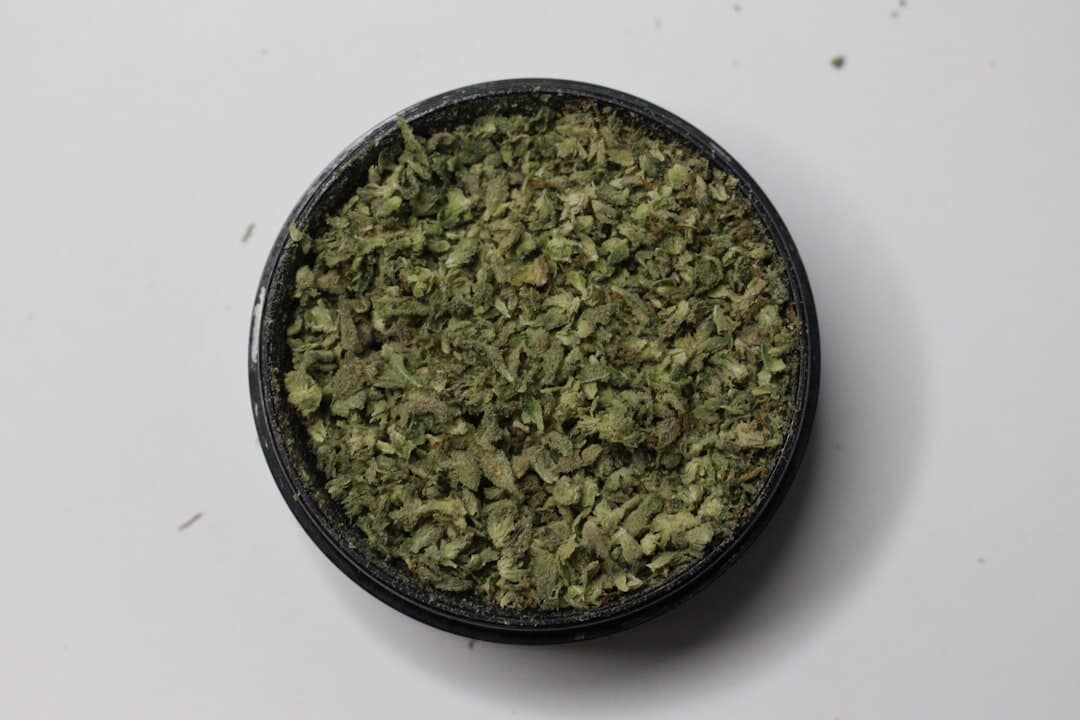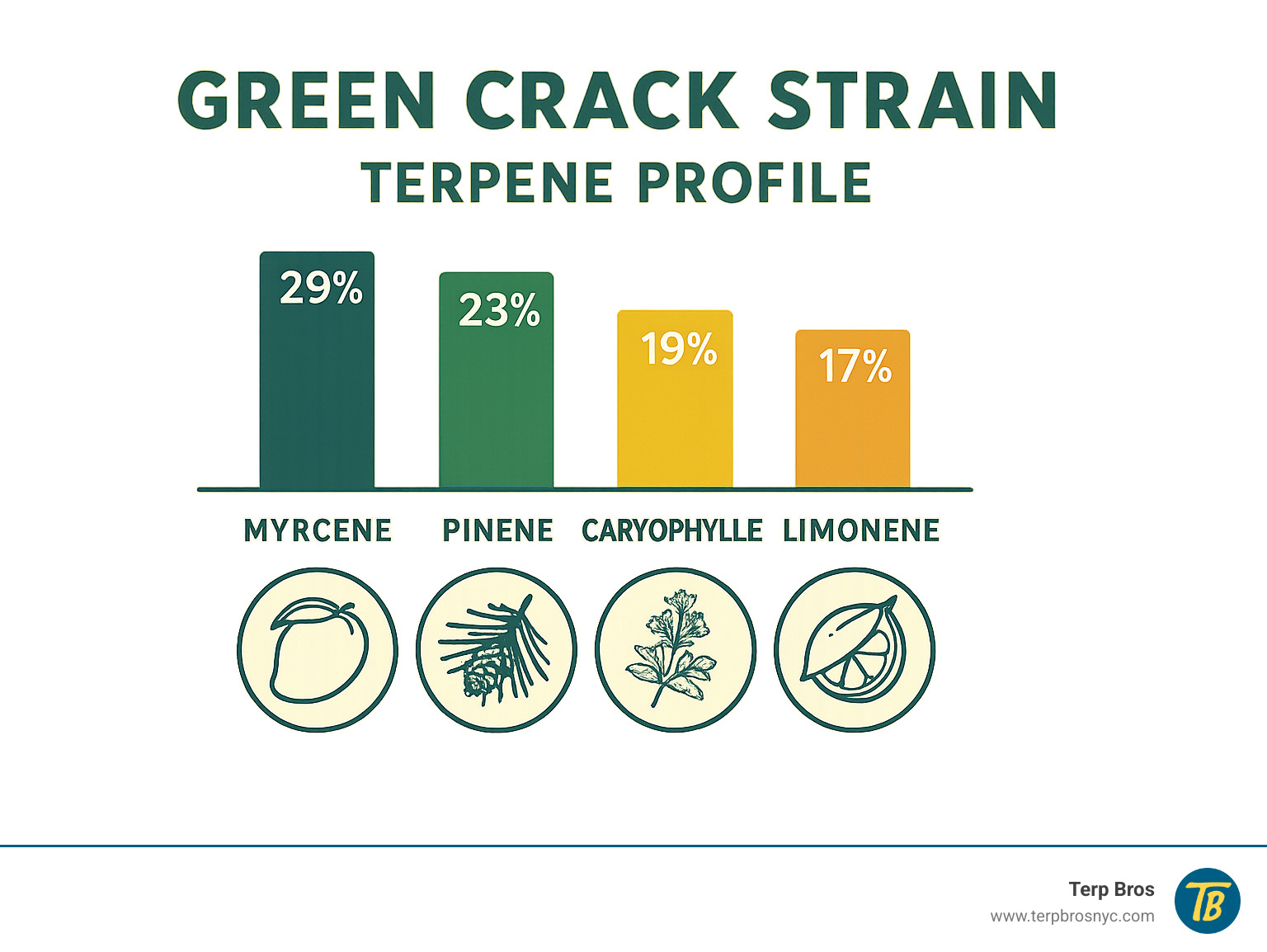
Green Crack Strain: 7 Amazing Reasons Fans Love It in 2025
The High-Energy Favorite: Understanding Green Crack Strain
The green crack strain is a potent sativa-dominant hybrid (65% sativa, 35% indica) known for its energizing and uplifting effects. Originally called “Cush” before being renamed by Snoop Dogg, this popular cannabis variety typically contains 13-25% THC with minimal CBD (0.1-0.2%) and approximately 1% CBG.
Quick Green Crack Strain Facts:
– Origin: Cross between Skunk #1 and an Afghani landrace
– Effects: Energetic, focused, talkative, creative
– Flavor Profile: Sweet mango, citrus, earthy notes
– Top Terpenes: Myrcene, pinene, caryophyllene
– Medical Benefits: Helps with stress (34% of users), depression (29%), anxiety (29%)
– Flowering Time: 7-9 weeks
– Yield: Up to 18oz/m² indoors, 20oz per plant outdoors
Green Crack delivers a sharp mental buzz that keeps you going throughout the day, making it perfect for morning use or whenever you need a boost of energy and creativity. Despite its moderate THC content, users report powerful effects that improve focus without the sedation typical of indica strains.
The strain’s distinct tropical mango aroma with citrus undertones comes from its unique terpene profile, which contributes to both its flavor and effects. Its bright green buds are often dense and resinous, showcasing indica-like structure despite its predominantly sativa effects.
I’m Jeremy Rivera, owner of Terp Bros, Astoria’s pioneering legal cannabis dispensary where the green crack strain remains one of our most requested varieties for customers seeking an energetic daytime option.
Green crack strain terms simplified:
– blue dream
– hybrid weed
– cbn cannabinoid
What Makes the Green Crack Strain Unique?
The green crack strain has carved out a special place in cannabis culture for good reason. Born in the 1970s in Athens, Georgia, this remarkable strain began life under the more subdued name “Cush.” Its genetic story combines the legendary Skunk #1 with a mysterious Afghani landrace strain, creating that perfect sweet spot of 65% sativa energy with 35% indica structure.
This strain might have remained just another quality option if not for Snoop Dogg himself. After experiencing its energizing effects, Snoop gave it the nickname “Green Crack” – not as a negative comparison, but as high praise for its powerful cerebral kick. While the name stuck and helped propel the strain to fame, many dispensaries (including us at Terp Bros) also use “Green Cush” or “Mango Crack” to be more sensitive to those uncomfortable with the original nickname.
The cannabis community formally recognized this strain’s excellence when it earned 3rd place for Best Sativa at the 2015 Denver High Times Cannabis Cup.
What truly sets Green Crack apart is its ability to deliver powerful mental stimulation without the heavy sedation that often comes with high-THC varieties. Looking at its impressive cannabinoid profile compared to its ancestors:
| Cannabinoid | Green Crack | Average Sativa | Parent (Skunk #1) |
|---|---|---|---|
| THC | 13-25% | 13% | 15-19% |
| CBD | 0.1-0.2% | <1% | <1% |
| CBG | ~1% | <0.5% | <0.5% |
That higher-than-average THC content, alongside notable CBG levels (which may contribute to its anti-inflammatory benefits), creates an experience that has built a dedicated following among those seeking productive energy from their cannabis.
Green Crack Strain Effects Breakdown
When you enjoy the green crack strain, you’re in for a truly cerebral ride that feels distinctly different from other cannabis experiences. Within minutes, most users feel a noticeable mental buzz that sharpens focus and improves concentration – it’s like having a cup of really good coffee, but with more creativity and fewer jitters.
The journey typically unfolds like this: First comes that initial rush of mental clarity and energy. As you reach the peak experience, you’ll notice improved focus, creative thinking, and often a desire to talk and connect. What’s special about Green Crack is how these effects sustain without a significant crash, gradually tapering off with minimal sedation.
What makes Green Crack a favorite at social gatherings is its remarkable ability to stimulate conversation. Rather than zoning out, users often become more engaged and talkative. This social quality makes it perfect for parties or hangouts where you want to remain present and interactive.
Why Is It Also Called Green Cush or Mango Crack?
The naming situation around this strain reveals something interesting about cannabis culture and how it’s evolving. Despite its popularity, many dispensaries (including us at Terp Bros) recognize that the “crack” terminology can be problematic.
First, the cannabis industry has worked hard to move past negative stereotypes, and references to hard drugs can reinforce harmful misconceptions. Second, for medical patients, discussing “Green Crack” with healthcare providers can create unnecessary discomfort. Finally, some regulatory frameworks discourage names referencing illicit drugs.
These concerns have led to the alternative names “Green Cush” (a return to its roots with a slight spelling change) and “Mango Crack” (highlighting its delicious flavor profile).
The “Mango” reference isn’t just clever marketing – it accurately captures the strain’s dominant flavor. Those sweet, tropical mango notes are immediately recognizable to experienced users and have become a defining characteristic that sets this strain apart.
Aroma, Flavor & Terpenes: Why Does Green Crack Taste Like Tropical Sunshine?
When you open a jar of the green crack strain, you’re immediately greeted by what many users describe as “tropical sunshine in a jar.” This isn’t just marketing hype – this strain delivers one of the most distinctive and genuinely enjoyable sensory experiences you’ll find in cannabis.
The first thing that hits you is that unmistakable sweet mango aroma. It’s lush, tropical, and instantly recognizable to experienced users. Behind that fruity frontline, you’ll detect the classic earthy undertones that reveal its Skunk heritage. Break open those bright green buds, and the aroma intensifies, releasing sharper citrus notes reminiscent of fresh lemon and lime zest, alongside subtle hints of pine and spice.
What creates this mouth-watering bouquet? It’s all about the terpenes – those aromatic compounds that give cannabis its distinctive scents and contribute to its effects.
When you actually taste the green crack strain, it delivers everything the aroma promises. That first inhale brings sweet tropical mango with bright citrus notes dancing across your palate. As you savor it, you’ll notice earthier, slightly skunky flavors emerging (thanks to its Skunk #1 parentage). The exhale leaves you with subtle spice and pine notes that finish clean without lingering heaviness.
Beyond just tasting amazing, these terpenes work with cannabinoids to create what scientists call the “entourage effect” – the idea that cannabis compounds work better together than alone. This synergy is what makes Green Crack’s effects so distinctive and enjoyable. Research published in scientific journals continues to explore how these compounds interact with our bodies to produce specific effects.
The strain also contains several important flavonoids like hesperetin, kaempferol, quercetin, and luteolin. These compounds not only contribute to flavor but may offer additional therapeutic benefits that researchers are still uncovering.
Dominant Terpene Profile of the Green Crack Strain
The magic of the green crack strain isn’t just in its THC content – it’s the unique terpene profile that shapes its distinctive experience. Let’s break down what makes this strain’s aromatic fingerprint so special:
Myrcene leads the pack as the most abundant terpene, providing those sweet, earthy base notes you first notice. While myrcene is typically associated with the “couch-lock” effect in indica strains, in Green Crack it works differently – helping improve cannabinoid absorption without dampening the energizing effects. It’s like myrcene provides the smooth runway for the THC to take off, while also offering anti-inflammatory benefits.
Pinene brings those crisp, fresh undertones that wake up your senses. Found naturally in pine needles and rosemary, this terpene promotes alertness and may help with memory retention. This explains why many users report improved focus with Green Crack compared to other high-THC strains.
Beta-caryophyllene is particularly fascinating because it’s the only terpene that also functions as a cannabinoid, directly activating CB2 receptors in your body. It contributes those subtle spicy, peppery notes while potentially offering anti-inflammatory and anxiety-reducing effects that help balance the strain’s stimulating properties.
Limonene rounds out the profile with bright citrus notes that lift your mood. This terpene is associated with stress relief and emotional elevation, helping explain why Green Crack users often report feeling both energized and genuinely happy without the jitters that can come with strong sativas.
Effects, Medical Benefits & Possible Side Effects
The green crack strain has gained a loyal following for its remarkable effects that benefit both recreational users and medical patients. Based on user feedback, this energizing strain effectively addresses several common conditions:
Stress relief tops the list, with 34% of users reporting significant reduction in their stress levels. Close behind are depression and anxiety management, each reported by 29% of users. Many people also note substantial help with fatigue and ADHD symptoms, making this a versatile option for various needs.
What makes Green Crack truly special is how it delivers relief without knocking you out. Unlike many medical cannabis varieties that leave you couch-locked, this strain allows you to medicate and still tackle your to-do list. This functional relief is why so many of our Terp Bros customers in Astoria choose it for daytime use.
For those battling chronic fatigue syndrome, Green Crack can be a game-changer. Its natural energy boost helps combat persistent exhaustion without the harsh crash that comes with energy drinks or excessive caffeine. The strain’s ability to improve dopamine activity likely explains this sustained energy effect.
ADHD patients frequently tell us that Green Crack helps them focus similarly to prescription medications but with fewer harsh side effects. Again, the dopamine-enhancing properties may be key here, as dopamine regulation is central to conventional ADHD treatments.
Of course, we should acknowledge the potential downsides:
Paranoia or anxiety can occur, especially with higher doses or in people already prone to anxiety. The energizing effects that many love can sometimes tip into uncomfortable territory for sensitive individuals.
Dry mouth and eyes are very common – keep water handy and consider eye drops if needed.
Insomnia can be an issue if used too close to bedtime. This is definitely a daytime strain!
Dizziness occasionally appears as a side effect, particularly with higher-THC versions.
At Terp Bros, we always recommend starting low and going slow when trying Green Crack for the first time. This is especially true if you’re sensitive to sativas or have experienced anxiety with cannabis in the past.
Who Should Use the Green Crack Strain—Daytime or Nighttime?
The green crack strain is your quintessential daytime companion. Its energizing, focus-enhancing qualities make it perfect for morning through late afternoon use. We generally suggest avoiding it within 4-6 hours of bedtime, as its stimulating effects might keep your mind racing when you’re trying to wind down.
Green Crack shines brightest for certain groups:
Students benefit from the improved focus and mental clarity when studying, writing papers, or tackling complex subjects. Many report better information retention and creative problem-solving – though we obviously recommend only for those of legal age!
Creative professionals often find that Green Crack helps them push through creative blocks while enhancing their thinking process. The energetic component helps sustain those creative sessions when you’re in the zone and don’t want to lose momentum.
Professionals looking beyond coffee sometimes replace or reduce their caffeine intake with small amounts of Green Crack. Many of our customers report enjoying the sustained energy without the jitters or crash that often comes with that fourth cup of coffee.
Outdoor enthusiasts particularly enjoy Green Crack before hiking, biking, or other outdoor activities. The energy boost combined with heightened sensory awareness can make nature experiences even more vivid and enjoyable.
A micro-dosing approach works beautifully with this strain. Using just enough to feel the mental stimulation without overwhelming effects allows for functional daytime use. This typically means consuming about 25-50% of your normal dose – something we’re happy to discuss with customers at our Astoria dispensary.
Typical Cannabinoid and Terpene Stats
Understanding what’s actually in the green crack strain helps explain why it feels the way it does. While individual batches vary depending on growing conditions, here’s what typical lab testing reveals:
Green Crack usually contains about 17-25% THC (averaging around 20%), with very low CBD (0-0.2%) and a notable CBG content of approximately 1% (higher than many strains). Various other minor cannabinoids like CBC and THCV appear in trace amounts.
This cannabinoid profile explains Green Crack’s potent mental effects (thanks to the high THC) while suggesting potential anti-inflammatory benefits from its CBG content. The minimal CBD explains why it doesn’t typically produce heavy body effects that might slow you down.
The terpene breakdown is equally important:
– Myrcene (0.4-0.8%): Provides those sweet, earthy base notes
– Pinene (0.3-0.6%): Contributes to alertness and memory retention
– Beta-Caryophyllene (0.2-0.5%): Offers potential anti-inflammatory effects
– Limonene (0.2-0.4%): Adds citrus notes and mood elevation
Growing the Green Crack Strain: Cultivation Tips for Home Gardeners
If you’re thinking about growing your own green crack strain, you’re in for a rewarding challenge. While not the toughest cannabis variety to cultivate, this energetic sativa-dominant plant does require some attentive care to reach its full potential.
Green Crack thrives best when you maintain these sweet-spot conditions:
– Temperature between 70-85°F (21-29°C)
– Humidity around 40-50% (you’ll want to drop this during flowering)
– Soil pH balanced at 6.0-6.5
– Well-draining soil or a hydroponic setup if you’re feeling adventurous
What I love about this strain is how it responds to training techniques. If you’re growing indoors with limited space, the Sea of Green (SoG) method works beautifully, letting you maximize your yield in tight quarters. Screen of Green (ScrOG) is another excellent approach that helps manage the plant’s height while creating more bud sites. Don’t be shy about topping and training those branches—your efforts will be rewarded with significantly heavier harvests.
One of Green Crack’s more appealing qualities for impatient growers is its relatively quick flowering period of just 7-9 weeks—pretty speedy for a sativa-dominant strain! Indoor cultivators can expect up to 18 ounces per square meter, while outdoor plants can produce an impressive 20 ounces per plant when everything goes right.
A word of caution though: green crack strain has a bit of a weakness when it comes to mold and mildew, especially in humid environments. Good ventilation and dehumidification are absolutely essential during the flowering phase when those dense buds are forming.
Growing the Green Crack Strain Indoors vs Outdoors
The green crack strain can thrive in both indoor and outdoor environments, but each approach comes with its own set of advantages and challenges.
Indoor Cultivation:
Growing Green Crack indoors gives you complete environmental control, which is particularly valuable for meeting this strain’s specific needs. A 600W HPS lighting system or equivalent LED setup provides the ideal spectrum and intensity to develop those resinous buds. Proper ventilation isn’t just recommended—it’s essential for preventing mold and managing the strain’s distinctive aroma.
Space planning is crucial too. Even with training, expect your plants to reach 3-4 feet indoors. The payoff for your careful attention can be up to 18 ounces per square meter after the 7-9 week flowering period (plus 3-4 weeks of vegetation).
The big advantage of indoor growing is year-round cultivation and protection from pests and weather extremes. The downside? You’ll need to invest in equipment and be prepared for higher energy costs. But for many growers, the consistent quality makes it worthwhile.
Outdoor Cultivation:
Green Crack absolutely loves outdoor environments with Mediterranean-like climates. Think Southern Europe or similar warm, dry areas. Plant after the last frost when nighttime temperatures consistently stay above 50°F, and you’ll be harvesting around late September to early October in the Northern Hemisphere.
The outdoor yield potential is impressive—up to 20 ounces per plant. Just be prepared for some giants in your garden, as these plants can stretch to 6-9 feet without training.
For soil composition, this strain prefers:
– A well-draining base with good aeration
– Moderate nutrient content (not overly rich)
– pH balanced between 6.0-6.5
– Beneficial microorganisms to support healthy root development
Troubleshooting Common Issues
Even experienced growers can run into challenges with the green crack strain. Here’s how to spot and solve the most common problems:
Nutrient Burn
Green Crack can be somewhat finicky about its feeding schedule, particularly when it comes to nitrogen. If you notice yellow or brown leaf tips that look “burned,” curling leaf edges, or unusually dark green leaves with a “claw” appearance, you’re likely dealing with nutrient burn.
The fix is straightforward: flush your growing medium with pH-balanced water to remove excess nutrients, then reduce your nutrient concentration by 25-30% when you resume feeding.
Bud Rot (Botrytis)
Those beautiful dense buds that make Green Crack so appealing can also be its weakness in humid conditions. Be on alert for brown, dying areas within buds, gray or white fuzzy mold, or a musty smell—all signs of dreaded bud rot.
If you spot any affected areas, act immediately. Remove the affected buds completely, improve air circulation around the plants, and reduce humidity to 40-45%.
Height Control Issues
The sativa genetics in Green Crack can lead to some impressive stretching, especially during early flowering. You might notice rapid vertical growth, increasing space between nodes, and plants that seem determined to outgrow their environment.
To keep things manageable, implement training techniques like LST (low-stress training) or topping early in the plant’s life. ScrOG nets are excellent for controlling vertical growth in indoor setups.
Where to Experience Green Crack in Queens, NY
When you’re ready to try the green crack strain for yourself, we’ve got you covered at Terp Bros. As Astoria’s first legal cannabis dispensary, we take pride in offering not just exceptional products, but also the knowledge and community support that makes every cannabis experience positive and meaningful.
Our journey from being justice-involved individuals to dispensary owners gives us a unique perspective on cannabis access. That’s why we’re especially proud to be part of New York’s CAURD program, which prioritizes licenses for those previously impacted by cannabis prohibition. This program represents a vital step toward repairing the harm done to communities disproportionately affected by the war on drugs.
If you’re curious about experiencing the energizing effects of Green Crack, we offer several ways to enjoy this popular strain:
Our Jaunty Cartridge – Green Crack 1g has become a customer favorite, offering the full spectrum of Green Crack’s uplifting effects in a convenient, discreet format. For those who prefer traditional methods, we also carry premium Green Crack flower and pre-rolls that showcase the strain’s tropical mango aroma and vibrant effects.
We understand that finding the right product can sometimes feel overwhelming, especially with potent sativas like Green Crack. That’s why our team is thoroughly trained to guide you toward the perfect match based on your experience level and desired effects. For first-time Green Crack users, we typically recommend starting with a lower dose to gauge how this energizing strain affects you personally.
Our delivery service reaches throughout Queens – from our home base in Astoria to Woodside, Jackson Heights, Flushing, Jamaica, Forest Hills, and beyond. We believe everyone deserves convenient access to quality cannabis, regardless of which neighborhood you call home.
Ready to experience the tropical energy of Green Crack for yourself? Browse our complete selection at Shop All Products or stop by our Astoria location to chat with our friendly, knowledgeable team about this remarkable strain.
Frequently Asked Questions about the Green Crack Strain
Is the Green Crack Strain a true sativa?
The green crack strain isn’t technically a pure sativa, but rather a sativa-dominant hybrid with about 65% sativa and 35% indica genetics. Don’t let that hybrid status fool you though – its effects lean heavily toward the sativa side of the spectrum, delivering that energizing, cerebral buzz that sativa enthusiasts crave.
The indica influence shows up more in how the plant grows and in its bud structure than in how it makes you feel. Its Skunk #1 parent contributes most of those uplifting sativa qualities, while the mysterious Afghani landrace adds just enough indica to round things out. This balanced heritage creates something special – mental stimulation without the anxiety that sometimes comes with pure sativas.
While truly 100% pure sativas are becoming increasingly rare in today’s cannabis world, Green Crack has earned its reputation as one of the most “sativa-feeling” strains you can find. When customers at Terp Bros ask for a classic daytime strain with authentic sativa effects, Green Crack is often our first recommendation.
What does the Green Crack Strain smell and taste like?
Open a jar of well-cured green crack strain, and you’ll immediately understand why some call it “Mango Crack.” The aroma hits you with sweet tropical fruits – primarily mango – backed by bright citrus notes and subtle earthy undertones.
When properly grown and cured, the smell is complex and inviting. That dominant mango sweetness leads the way, followed by zesty lemon notes, a hint of that classic skunkiness (thanks to its Skunk #1 parentage), and delicate whispers of pine and spice in the background.
The flavor delivers everything the aroma promises. Your first inhale brings a wave of sweet, tropical fruitiness that coats your palate. As you exhale, those citrus notes become more pronounced, finishing with a slightly spicy, earthy aftertaste that balances the sweetness perfectly.
This mouthwatering profile comes from Green Crack’s unique terpene mix – primarily myrcene (creating those sweet, earthy notes), limonene (responsible for the citrus), pinene (adding freshness), and beta-caryophyllene (bringing the spice). Together, they create that signature tropical experience that keeps customers coming back to our Astoria dispensary time after time.
How strong is the Green Crack Strain’s THC content?
The green crack strain typically packs a THC punch ranging from 13% to 25%, with most of the products we carry at Terp Bros falling between 17% and 22%. This puts it in the moderately high to high category compared to average cannabis strains.
Here’s what makes Green Crack interesting though – it often feels stronger than its THC percentage might suggest. Many of our customers report that it hits harder than other strains with similar or even higher THC levels. This probably happens because its specific terpene profile improves THC’s effects through what scientists call the “entourage effect.”
To put this in perspective, the average cannabis strain contains about 12-15% THC, and the average sativa hovers around 13%. Green Crack’s typical 17-22% range (with some exceptional samples reaching 25%) definitely places it in the higher-potency category.
The strain also contains about 1% CBG (cannabigerol), which is higher than many other varieties. This often-overlooked cannabinoid might contribute to Green Crack’s anti-inflammatory properties and unique effects profile.
Its CBD content is minimal (usually just 0.1-0.2%), which explains why you don’t get that heavy, sedative feeling often associated with higher-CBD strains. This cannabinoid balance creates Green Crack’s characteristic clear-headed, energetic high without the “couch-lock” effect you’d get from indica-dominant varieties.
If you’re new to cannabis or sensitive to THC, we always recommend starting with a small amount of Green Crack and waiting at least 15-30 minutes before considering more. Its energizing effects can sometimes catch even experienced users by surprise – in a good way, but moderation is key to a positive experience!










